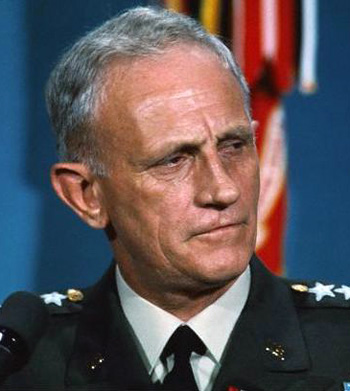
|
Harold K. Johnson |
 |
|||
| Rank, Service | ||||
General O-10, U.S. Army |
||||
| Veteran of: | ||||
|
||||
| Tribute: | ||||
Harold Johnson was born on February 22, 1912, in Bowesmont, North Dakota. He enlisted in the North Dakota National Guard on January 7, 1929, and received an honorable discharge to enter the U.S. Military Academy at West Point on August 20, 1929. He was commissioned a 2d Lt of Infantry on June 13, 1933, and then served with the Civilian Conservation Corps at Deer River, Minnesota, from September to December 1933. His next assignment was as Commanding Officer of Company C and then Company M of the 3rd Infantry Regiment at Fort Snelling, Minnesota, from January 1934 to July 1937, followed by attendance at The Infantry School at Fort Benning, Georgia, from August 1937 to June 1938. Lt Johnson served with the 28th Infantry Regiment at Fort Niagara, New York, from July 1938 to June 1940, and then served with the 57th Infantry Regiment of the Philippine Scouts at Fort William McKinley in the Philippines from August 1940 until he was taken as a Prisoner of War at Bataan on April 9, 1942. After spending 1,249 days in captivity, and having survived the Bataan Death March, Col Johnson was released on September 8, 1945. He was briefly hospitalized to recover from his injuries, and then served at Fort Sam Houston, Texas, from November 1945 to February 1946, followed by studies at The Armored School at Fort Knox, Kentucky, and The Infantry School at Fort Benning, from March to August 1946. Col Johnson attended Command and General Staff College at Fort Leavenworth, Kansas, from September 1946 to July 1947, and then remained on the faculty as an instructor in the School of Combined Arms until August 1949. He next attended Armed Forces Staff College in Norfolk, Virginia, from August 1949 to January 1950, and then served as Commanding Officer of the 3rd Battalion, 7th Infantry Regiment at Fort Devens, Massachusetts, from May to August 1950. His next assignment was as Commanding Officer of 3rd Battalion, 8th Cavalry Regiment of the 1st Cavalry Division in Korea from October 1950 to February 1951, followed by service on the staff of I Corps with the Far East Command from February to October 1951. He served as Policy and Training Officer in the Office of the Chief of Army Field Forces at Fort Monroe, Virginia, from December 1951 to July 1952, and then attended the National War College in Washington, D.C., from August 1952 to June 1953. He served with Headquarters U.S. Army in the Pentagon from July 1953 to January 1956, followed by service as Assistant Commander of the 8th Infantry Division at Fort Carson, Colorado, and then in Europe, from January 1956 to September 1957. Gen Johnson next served as Chief of Staff of 7th Army in Europe from September 1957 to March 1959, and then on the staff of U.S. Army Europe from april 1959 to July 1960. His next assignment was as Commandant of U.S. Army Command and General Staff College at Fort Leavenworth from August 1960 to January 1963, followed by service on the staff of Headquarters U.S. Army from February 1963 to July 1964. Gen Johnson's final assignment was as the 24th Chief of Staff of the Army from July 3, 1964 until his retirement from the Army on July 2, 1968. Harold Johnson died on September 24, 1983, and was buried at Arlington National Cemetery. |
||||
|
||||

